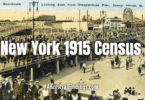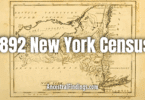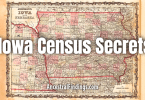The 1960 U.S. Census sits just over the horizon, scheduled to be released to the public on April 1, 2032. It’s a highly anticipated snapshot of American life during a time of rapid change: the rise of suburbia, the baby boom cresting, the Cold War in full effect, and the Civil Rights Movement gaining national attention. For genealogists, it promises to unlock new details about ancestors who lived in the modern era—but for now, it remains sealed under the federal 72-year privacy law.
So, what can we expect when it does become available—and how can we prepare to use it?
What Makes the 1960 Census Special?
When the 1960 census was taken, the U.S. population had reached 179 million. The country had shifted dramatically in the decade since 1950, with more people living in the suburbs, more households owning televisions and cars, and a rising middle class shaped by postwar economic growth. It was also the first census to rely heavily on computer tabulation and sampling techniques, which means the data collection was more efficient—but the format will look different from what researchers are used to.
Key expected categories likely to include:
- Full names of household members
- Age, sex, race, and marital status
- Relationship to the head of household
- Place of birth
- Residence five years earlier (likely 1955)
- Occupation and industry
- Employment status and class of worker
- Education level
- Possibly homeownership status and income (for sample populations)
Because the 1960 census was taken during the peak of the baby boom, it will be a critical record for identifying the children born to WWII-era couples. Many researchers are excited about locating relatives in their childhood homes—some of whom may still be alive today.
Free Census Record Lookups
Why It Matters to Family Historians
The 1960 census may be the first federal census to list your parents, aunts, uncles, or even yourself if you were born before April 1, 1960. That makes it a powerful bridge between modern and historical records, helping families flesh out stories that are still within living memory.
It also captures a generation raised during war and Depression, now reaching adulthood. Many of the young children listed in 1940 or 1950 will be homeowners or workers in 1960. This allows researchers to trace economic progress, educational shifts, and social mobility in more detail.
For African American genealogy, the 1960 census arrives just before the Civil Rights Act of 1964. It will help locate families during the Great Migration into Northern and Western cities and clarify neighborhood, school, and employment patterns that reflect segregation and systemic shifts.
Anticipated Pros
- Likely clearer relationships among household members
- Stronger data from a more mobile, documented society
- Expansion of suburbs and new towns documented for the first time
- Richer employment and educational information for both men and women
- First-time appearance of many Baby Boomers in census records
- Potential to connect to later records, such as marriage licenses, property deeds, and yearbooks
Anticipated Cons
- Like previous censuses, the 1960 census will not include Social Security Numbers, specific street addresses in many areas, or full income breakdowns except for sampled households
- Sampling means not all questions will be answered for every person
- The use of early computer processing may create indexing or formatting quirks that researchers will need to learn how to navigate
- Some digitization errors may exist when it’s first released—just like the early hiccups seen with the 1950 release
How to Prepare Now
While you wait for the 1960 census to become available, you can still make excellent use of the records you already have. Here’s what you can do to lay the groundwork:
- Build complete family profiles using the 1940 and 1950 censuses
- Review city directories, school records, and military records from the 1950s
- Gather photos and oral histories now from relatives who were alive in 1960
- Note every relative born before April 1, 1960—these will be searchable
- Start learning about the neighborhoods and suburbs your family lived in, including any postwar housing developments, redlining histories, or zoning changes
Why the 1960 Census Will Be Worth the Wait
The 1960 census stands at a cultural and demographic pivot. It offers the last snapshot before the upheavals of the 1960s began—before Vietnam, before the assassination of JFK, before the moon landing, and before the explosion of civil rights legislation. It’s the beginning of a more connected, televised, and documented age.
For genealogists, it will be more than just data. It’s the missing link between traditional family records and the age of modern identity.
When it finally opens in April 2032, the 1960 census will help answer the questions we’ve been asking for decades—and will likely spark a thousand new ones.
Comparing the 1960 and 1860 Censuses: A Century Apart
Now that we’ve explored what the 1960 census will offer, it’s worth comparing it to its counterpart taken 100 years earlier: the 1860 census.
The contrast is stark. In 1860, America was largely rural, divided over slavery, and just months away from civil war. Most people lived on farms or in small towns. The federal government was limited in scope, and few people lived far from where they were born. The census was taken by hand, often inconsistently, and recorded minimal detail for enslaved people, if any.
By 1960, the country was global, industrial, and deeply connected. The census was computerized, urban migration had skyrocketed, and middle-class families were buying homes in planned subdivisions. Education levels had risen dramatically, and the federal government played a far larger role in daily life. It was also a time when women were entering the workforce in greater numbers, television was reshaping culture, and the civil rights movement was underway.
In 1860, the census might tell you if someone could read or write. In 1960, it could tell you how many years of school they completed. In 1860, it might list your ancestor’s real estate value. In 1960, it could reveal their income, occupation, hours worked, and place of residence five years earlier.
Yet despite all the changes, both censuses share a common purpose: they freeze a moment in time. One captures a nation at war with itself. The other shows a nation on the verge of massive social transformation.
Both are powerful tools for telling our family stories. And by using them together—drawing connections across a hundred years—you gain a much deeper understanding of how your family lived, endured, moved, and grew.
So whether you’re waiting for the future of family research to unlock in 2032 or working with ancestors who lived under the shadow of the Civil War, the U.S. census remains one of the most vital resources we have for piecing together the American story.






